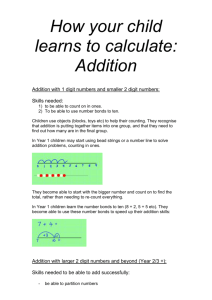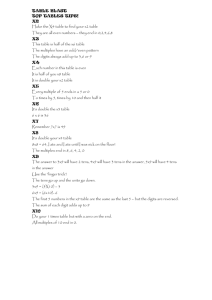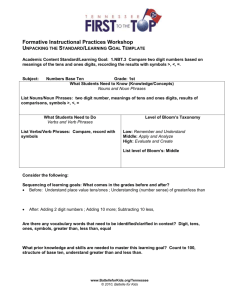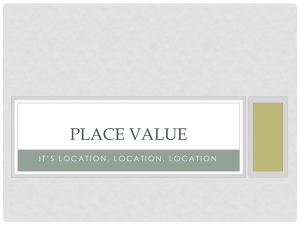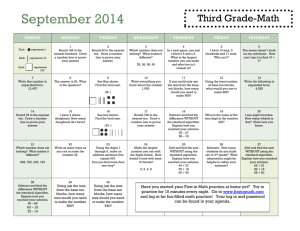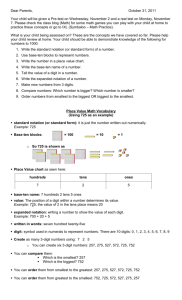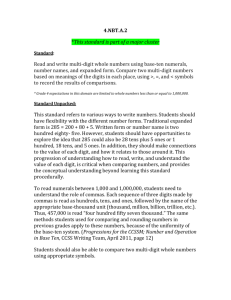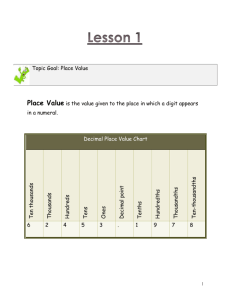5nbta1 unpacked
advertisement
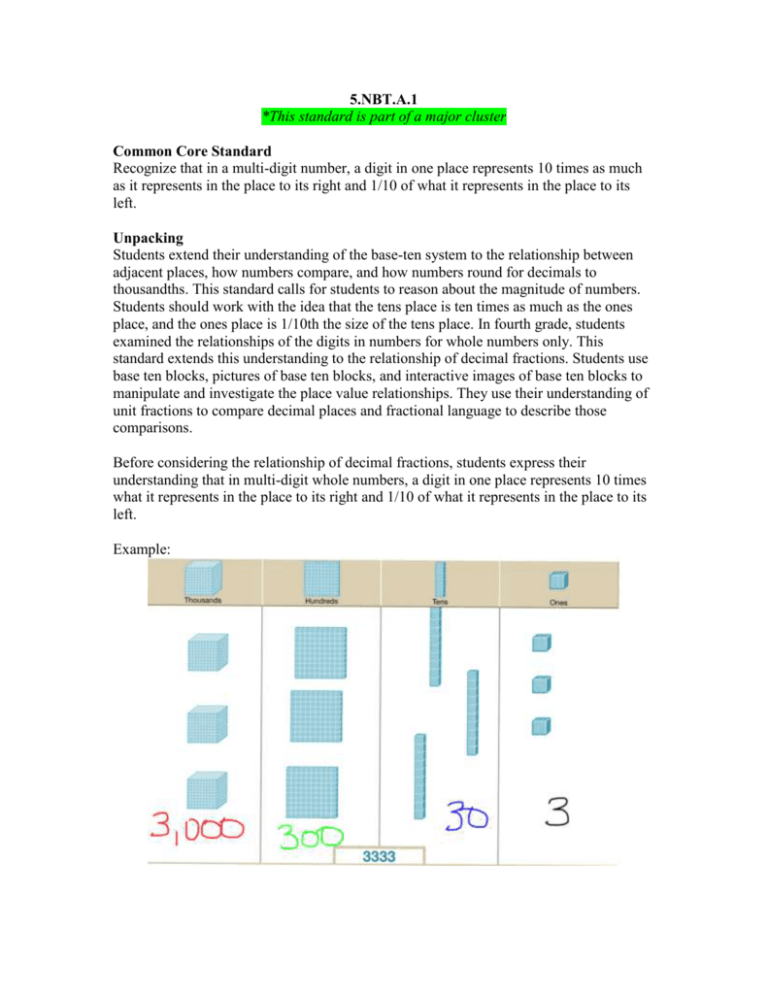
5.NBT.A.1 *This standard is part of a major cluster Common Core Standard Recognize that in a multi-digit number, a digit in one place represents 10 times as much as it represents in the place to its right and 1/10 of what it represents in the place to its left. Unpacking Students extend their understanding of the base-ten system to the relationship between adjacent places, how numbers compare, and how numbers round for decimals to thousandths. This standard calls for students to reason about the magnitude of numbers. Students should work with the idea that the tens place is ten times as much as the ones place, and the ones place is 1/10th the size of the tens place. In fourth grade, students examined the relationships of the digits in numbers for whole numbers only. This standard extends this understanding to the relationship of decimal fractions. Students use base ten blocks, pictures of base ten blocks, and interactive images of base ten blocks to manipulate and investigate the place value relationships. They use their understanding of unit fractions to compare decimal places and fractional language to describe those comparisons. Before considering the relationship of decimal fractions, students express their understanding that in multi-digit whole numbers, a digit in one place represents 10 times what it represents in the place to its right and 1/10 of what it represents in the place to its left. Example: Students can create a number with the same digit in each place value using base-ten blocks Have students’ reason about the difference in the values of each place value. Have students ‘ use a calculator to explore the patterns between each place value. Such as 300 X n = 3,000 and 300 ÷ n = 30. Once they manipulate several numbers, they might create statements describing the patterns that they noticed. Example: The 2 in the number 542 is different from the value of the 2 in 324. The 2 in 542 represents 2 ones or 2, while the 2 in 324 represents 2 tens or 20. Since the 2 in 324 is one place to the left of the 2 in 542 the value of the 2 is 10 times greater. Meanwhile, the 4 in 542 represents 4 tens or 40 and the 4 in 324 represents 4 ones or 4. Since the 4 in 324 is one place to the right of the 4 in 542 the value of the 4 in the number 324 is 1/10th of its value in the number 542. Example: A student thinks, “I know that in the number 5555, the 5 in the tens place (5555) represents 50 and the 5 in the hundreds place (5555) represents 500. So a 5 in the hundreds place is ten times as much as a 5 in the tens place or a 5 in the tens place is 1/10 of the value of a 5 in the hundreds place. Base on the base-10 number system digits to the left are times as great as digits to the right; likewise, digits to the right are 1/10th of digits to the left. For example, the 8 in 845 has a value of 800 which is ten times as much as the 8 in the number 782. In the same spirit, the 8 in 782 is 1/10th the value of the 8 in 845. To extend this understanding of place value to their work with decimals, students use a model of one unit; they cut it into 10 equal pieces, shade in, or describe 1/10 of that model using fractional language (“This is 1 out of 10 equal parts. So it is 1/10”. I can write this using 1/10 or 0.1”). They repeat the process by finding 1/10 of a 1/10 (e.g., dividing 1/10 into 10 equal parts to arrive at 1/100 or 0.01) and can explain their reasoning, “0.01 is 1/10 of 1/10 thus is 1/100 of the whole unit.” In the number 55.55, each digit is 5, but the value of the digits is different because of the placement. The 5 that the arrow points to is 1/10 of the 5 to the left and 10 times the 5 to the right. The 5 in the ones place is 1/10 of 50 and 10 times five tenths. The 5 that the arrow points to is 1/10 of the 5 to the left and 10 times the 5 to the right. The 5 in the tenths place is 10 times five hundredths Questions to check for understanding and increase rigor: How is the value of 3 different in 493 and 9.34? Draw an illustration to support your reasoning. Explain your thinking. How are .7, 7, 70 related? Illustrate and explain your reasoning. Why is 35 x 10 = 350? Draw pictures and/or use number sentences to illustrate your explanation. Explain why 6 ÷ 10 = .6 Explain the difference when you multiply 6 X10. Draw pictures and or use number sentences to illustrate your explanation. Jesse puts 10 jellybeans on a scale and the scale reads 12.0 grams. How much would you expect 1 jellybean to weigh? Why? How are 24 and .24 alike and different? * In addition to the above questions, push student thinking by asking them to model using manipulatives, number lines, technology, base ten blocks, drawings, etc. to support their thinking.

